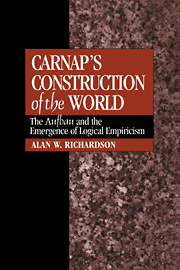Book contents
- Frontmatter
- Contents
- Acknowledgments
- Introduction
- 1 Reconstructing the Aufbau
- 2 The problem of objectivity: An overview of Carnap's constitutional project
- 3 An outline of the constitutional projects for objectivity
- 4 The background to early Carnap: Themes from Kant
- 5 The fundamentals of neo-Kantian epistemology
- 6 Carnap's neo-Kantian origins: Der Raum
- 7 Critical conventionalism
- 8 Epistemology between logic and science: The essential tension
- 9 After objectivity: Logical empiricism as philosophy of science
- Bibliography
- Index
3 - An outline of the constitutional projects for objectivity
Published online by Cambridge University Press: 30 October 2009
- Frontmatter
- Contents
- Acknowledgments
- Introduction
- 1 Reconstructing the Aufbau
- 2 The problem of objectivity: An overview of Carnap's constitutional project
- 3 An outline of the constitutional projects for objectivity
- 4 The background to early Carnap: Themes from Kant
- 5 The fundamentals of neo-Kantian epistemology
- 6 Carnap's neo-Kantian origins: Der Raum
- 7 Critical conventionalism
- 8 Epistemology between logic and science: The essential tension
- 9 After objectivity: Logical empiricism as philosophy of science
- Bibliography
- Index
Summary
we are now in a position to undertake a closer examination of the details of the actual projects for achieving objectivity presented in Der logische Aufbau der Welt. An outline of Carnap's levels of constitution is, therefore, in order. In this way, we will be able to see what Carnap is doing in his two projects. Again, many questions about constitution and the order of the definitions will not be addressed in order to focus our attention solely on the question of the way the constitutional system explicates the objectivity of scientific claims.
THE LOWEST LEVELS OF THE CONSTITUTIONAL SYSTEM
The constitutional system meant to mirror the epistemic primacy relation begins, as we have noted, from a single relation, the “recollection of similarity” relation (Rs), over total cross-sections of experience at a time. Carnap's first order of business in the constitutional system is to constitute the rich texture of individual psychological life, the auto psychological domain, from this slender basis (cf., esp. §§108–20). Our primary concern is with the role of the auto psychological domain in the construction of objectivity, so I shall only sketch the definitions here. Of primary importance for our purposes is the final accounting of the auto psychological domain and the transition to the world of physics.
Before discussing the definitions, there is a noteworthy aspect of Carnap's procedure that warrants a brief mention. In accordance with the methodological strictures of “purely structural definite description” (PSDD), the definitions depend only on the structure of the recollection of similarity relation, but this structure is itself only empirically known.
- Type
- Chapter
- Information
- Carnap's Construction of the WorldThe Aufbau and the Emergence of Logical Empiricism, pp. 65 - 91Publisher: Cambridge University PressPrint publication year: 1997



